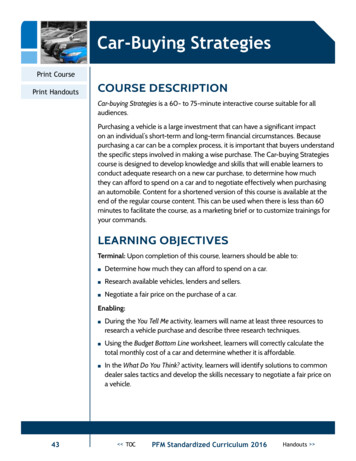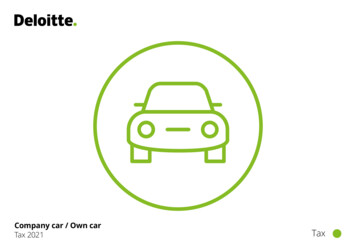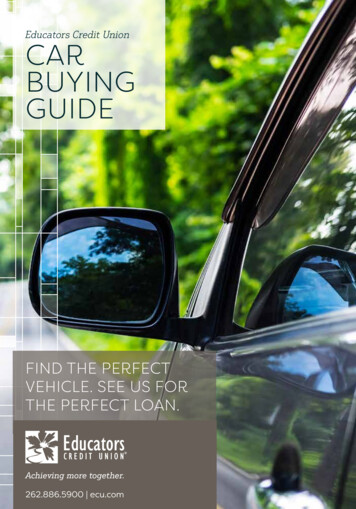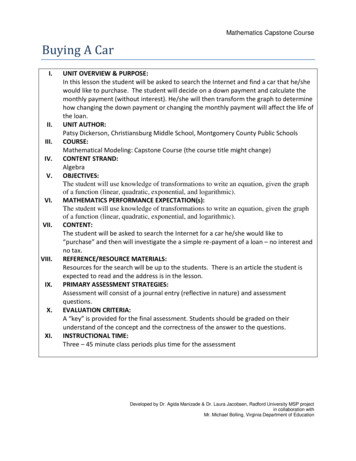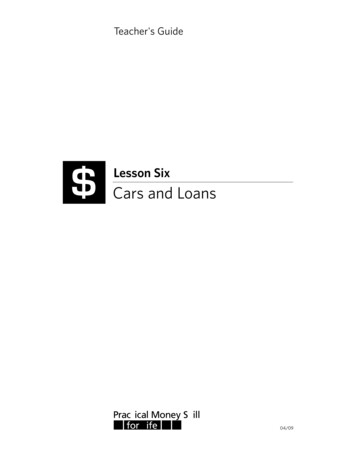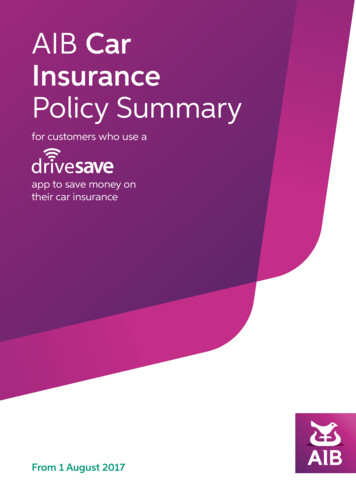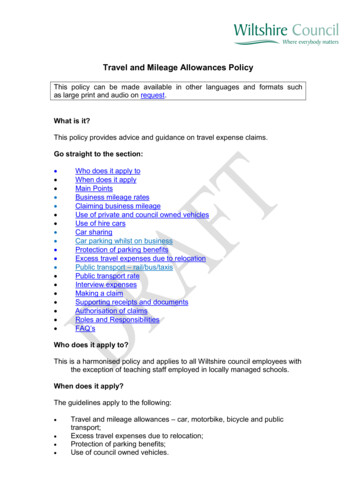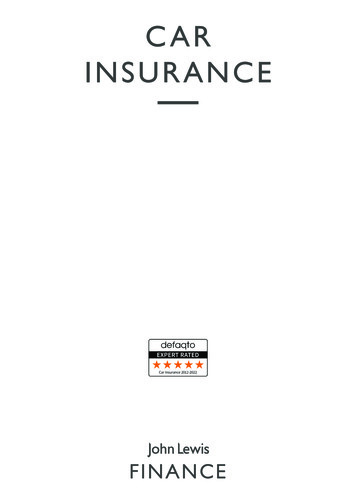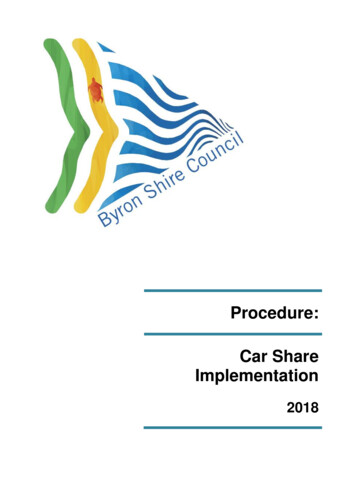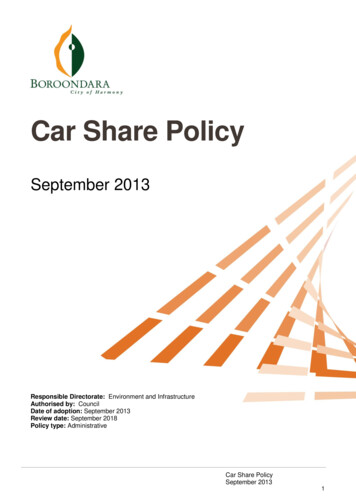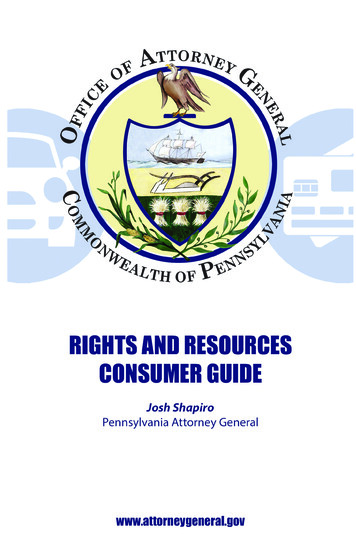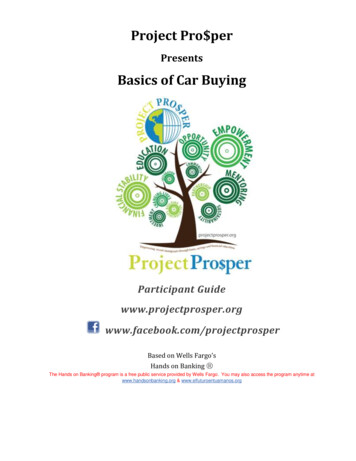
Transcription
Project Pro perPresentsBasics of Car BuyingParticipant tprosperBased on Wells Fargo’sHands on Banking The Hands on Banking program is a free public service provided by Wells Fargo. You may also access the program anytime atwww.handsonbanking.org & www.elfuturoentusmanos.org
Page 1ContentsBefore you Shop . 2What is your budget? . 2Buying New vs. Buying Used Cars. 3Now you know, what's next . 4Financing . 4Important Next Steps . 5Car Affordability Activty . 6Important Car Terms . 6Depreciation . 6Repossession . 7Should I Lease? . 8Smart Car Shopping Reminders . 8Before You Sign . 9Glossary . 10Post Test . 12For more information about our smallNo-interest loan program for immigrants and refugees you can reach us projectprosperJoin Our Facebook Group: Project Prosper: Money TalksBasics of Car Buying 2017
Page 2SMART CAR SHOPPINGI. BEFORE YOU SHOP1. The BasicsA. If you’re thinking of buying a car there’s a lot to consider. What is your car BUDGET? Will you finance, buy with cash, or lease the vehicle? What are the vehicle's maintenance costs? How to find and buy the right car to meet your needs?2. What is your car Budget?To determine what car you can afford, you will need to consider the following:1. Based on your situation, what type of vehicle will fill your transportation needs now and in the nextfew years?2. CAR PAYMENT (car note)- this is the monthly loan INSTALLMENT you will have to pay the bank orcar dealership until the car loan is completely repaid plus interest.3. Insurance Cost- Car insurance is required in the State of Florida. The cost of insurance varies basedon the vehicle size, year, and condition of vehicle (New or Used). Remember, your driving recordand credit score also affect your insurance premium.4. Maintenance and Repairs- To help keep your car in excellent condition you have to do regularmaintenance. This could be a monthly, quarterly, or yearly cost. The most common maintenance for cars is oil changes ( 15 and up depending on vehicleand local deals). Unforeseen costs happen all the time. The most common repairs include - flat tires, newwiper blades, new tail or head lights, dead battery.o Some cars require high quality parts and oil. You want to know what your carrequires before you buy it. Not all cars are the same!Basics of Car Buying 2017
Page 35. FUEL ECONOMY- This is the cost of gas to use your car. Some cars/trucks have better fueleconomy than others. Remember as gas prices rise and fall this will affect your monthly budget.Also, some cars REQUIRE premium gas not regular unleaded.Here is a comparison chart showing fuel costs for various size and styles of vehicles.2015 Toyota Prius2015 Ford F150Pickup 2WD1.8 L, 4 cyl, Automatic(variable gear ratios)2.7 L, 6 cyl, Automatic(S6), TurboCost to Drive25 MilesCost to Fill theTankTank Size2015 Nissan Altima2015 DodgeChallenger3.5 L, 6 cyl, Auto(AV-S7) 5.7 L, 8 cyl, Manual 6-spd 1.09 2.48 2.10 3.69 26 50- 78 39 4911.9gallons23.0-36.0 gallons18.0 gallons18.5 gallons3. Buying New vs. Buying Used CarsBenefits of buying a new carA. Warranty New cars can come withwarranties up to 10 years or100,000 miles.B. Latest features and options You'll have flexibility to ordera new car with the featuresand options you want.C. Top Condition A new car should have noprevious wear, mechanicalproblems or body damage.Drawbacks of buying a new carD. Higher Price The purchase price of a new car ishigher than a used car.E. Instant Depreciation A new car depreciates by 15% ormore the minute you buy it.F. Higher insurance/taxes/fees Generally higher for a new car.Basics of Car Buying 2017
Page 4Benefits of buying a used carG. Lower Price I. Higher loan interest rateUsed cars cost less and can be abetter value. Buying from aprivate seller might get you abetter price, but the seller maynot allow you to return itH. Declining Depreciation Drawbacks of buying a used carUsed cars continue to depreciate,but cars typically depreciate themost during the first 3 years. A loan for a used car may carryhigher interest rates because the carvalue is harder to assess and carriesmore risk for the lender. Older cars may not qualify for loans.J. Limited or no Warranty A car from a private seller may notcarry a warranty. Used car dealersmay not offer a warranty.K. More Maintenance NeedsII. NOW YOU KNOW WHAT YOU WANT.WHAT'S NEXT?Unless you were able to pay the total cost of the car with cash, you will have to FINANCE the vehicle. Thismeans a bank, credit union or car dealership will loan you the money for the car. You will have immediate useof the car, however, you will have to repay this loan monthly (or however the contract reads) until the car ispaid off. Included in this monthly installment will be interest charges. The amount of interest depends on yourpersonal credit rating.A. Other factors that affect your monthly payment:1. Down Payment a. This is money that you have saved to put towards the purchase of the vehicle.b. Most financial institution and/or dealerships require some type of down payment.c. A larger down payment will decrease your monthly payment, and the amount of interest youpay. This is because you will borrow less money from the lender.1. Loan term (amount of time you will take to pay back the loan)2. Property Vehicle Tax and TagsThough these do not affect your monthly payment, you do have to pay these costs upfront andannually. It is illegal to drive a car without paying these taxes.a. Florida title and registration of a vehicle costs approximately 420.b. The state of Florida imposes 6% sales tax on the full purchase price.Basics of Car Buying 2017
Page 5c. Each year when you pay for registration, you will receive a small yellow sticker that goes onyour back license plate. Registration is good for year, and expires in the month of yourbirthday.III. IMPORTANT NEXT STEPSA. Can I afford these payments?1. After you pay all of your other bills, how much money do you have available to pay theongoing expenses of car ownership (fuel, insurance, maintenance, registration, parking, and more).2. Try to keep your car expenses within a range you can consistently afford through life’s upsand downs (i.e. income loss, new baby, etc.).B. TRY BEFORE YOU BUY - Used Car1. Before buying, review maintenance documentation and check the car during the day.2. Hire a mechanic for inspection or consult a service like Car Fax to see if it has been involved in anaccident.3. Always test drive the car whether it's new or used.C. Where can I RESEARCH my vehicle options?4. Research the vehicle year and model you want to purchase on one or all of these valuableconsumer websites:i. Kelly Blue Book- www.kbb.comii. Edmunds- www.edmunds.comiii. Google Reviews- www.google.com1. Search for the car name with the word reviews behind it (i.e. 2012 KiaOptima Reviews)iv. Consumer Reports- www.consumerreports.orgv. Car Fax report- www.carfax.com1. This is a report that tells you the history of the vehicle by entering thevehicle’s VIN number. The history will include any past reportedaccidents, correct mileage, and possibly maintenance records.2. Usually, the car dealer will offer you this report upon request.3. You the consumer can access the report at the listed website for a cost.5. Doing research on a car before you visit the dealer or private owner, will allow you more powerto NEGOTIATE.a. Negotiating is to offer a lower price than the asking price. This is a common practice ofall cultures.Basics of Car Buying 2017
Page 6b. Negotiate based on car cost and loan APR. Don't negotiate on the basis of the monthlypayment for vehicle. This may cause you to pay significantly more than the value of thevehicle.c. Things to help you negotiate for better car price Larger down payment Trade in vehicle value - this is a car that you currently own that you will trade infor a newer car. Remember, ask the dealer for CAR FAX report to learn about the car's historyand value. Request the factory invoice “tissue”. This invoice will show you what the dealerpaid for the car.D. Car Affordability ActivityJosefa has a full time job where she earns 11/hour. Her monthly net income is around 1549/Month. Josefahas been diligently saving money to buy a car and to date, she has saved 4,500. She can afford 200/max amonth for a car. Josefa finds a 2013 gold Toyota Corolla CE four-door sedan that is being sold by a privateseller. It has an automatic transmission; air conditioning; power windows and locks; cruise control and a CDplayer. It appears to be in excellent condition, with 33,000 miles. The seller is asking 12,996, but Josefa onlyhas 4,500. Put Josefa's next steps in order 1 (first) -6 (last).Buy insuranceNegotiate the sales price downApply for a car loan from a financial institution (to cover the remaining costsafter she pays 4500)Test Drive the VehicleObtain a Car Fax reportResearch the year, make and model of the car on websites like kbb.com or EdmundsIV. IMPORTANT CAR TERMINOLOGYA. Depreciation1. Depreciation is when the value of a car goes down due to normal wear and tear over time.2. The value of a new car can drop hundreds or even thousands of dollars the day you drive it offthe car dealer’s lot.3. Almost all cars depreciate over time, however, new cars depreciate more quickly than used cars.4. How much your car will depreciate depends on many factors—the make, model, year, whereyou live and how much you drive.Basics of Car Buying 2017
Page 7B. Car Title1. Certificate of title (also known as a car title or pink slip) is a legaldocument that establishes the legal owner of a vehicle. Car titles in theU.S. are commonly issued by the state Department of Motor Vehicles.1. Identifying information about the vehicle, normally at minimumits vehicle identification number, make, and year of manufacture.2. The license plate number.3. Technical information about the vehicle to define its taxationregime, e.g., its gross vehicle weight, motive power, and purchaseprice when new.4. The name and address of the purchaser or "registered owner" whowould normally possess and use it.5. If money is owed on the vehicle, the name of the lender or"lienholder" to whom this money is owed.C. “As Is” Purchase1. This car has no warranty. "What you see is what you get." The seller will not repair anythingthat goes wrong with the car after the purchase.D. Options1. Extra items such as upgraded stereo, side airbags, sunroofs etc. Sometimes these options canbe grouped in packages like a luxury or sports options.E. Service Contract1. Purchased by the buyer at the time of the car purchase and provides maintenance for aspecific period of time. These contracts cost extra. Questions to ask: Who will fulfill the contract? Dealer, Manufacturer, Independent Contractor? What are the deductibles? Do you have to pay for services upfront and apply for reimbursement later?F. Repossession1. This is what happens when a buyer DEFAULTS on a car loan. The lender has the right toretake possession of the car. Remember, until you have the car title in hand, you do not own the car.Basics of Car Buying 2017
Page 8V. SHOULD I LEASE?When you lease a car you are entering into a long term rental agreement. This agreement allows you to usethe car like you own it, but you must return it at the end of the lease unless you decide to buy the car.AdvantagesDisadvantagesYou can lease a brand new car that you maynot be able to afford to finance.At the end of the lease, you do NOT own thecar. If you terminate the lease before the endof the contract you may have to pay fees.Down payments are usually lower as well as Buying the car at the end of the lease couldmonthly payments.cost you more money than if you received atraditional loan in the first place.Your lease could coincide with theYou are limited in the number of miles thatmanufacturer's warranty which would mean you can put on the vehicle during your lease.the car is fully covered while in yourIf you exceed that mileage, you will owepossession.more at the end of the lease term.If you are business owner, this may be aYou are responsible for the maintenancegood option if you use the vehicle forand wear on the vehicle. You will have tobusiness purposes. Ask a tax advisor forpay more money at the end of the lease ifmore info.“wear and tear” on the car exceeds theleasing company’s expectations.VI. SMART CAR SHOPPING REMINDERSA. Shop for your car loan1. Shop for your loan before you shop for your car. Consider asking your bank, credit union or other lender for pre-approval of yourloan. If you’re pre-approved, then you can shop for a car in your pre-approvedprice range with confidence. If you know your credit score, you can tell the score to the dealer to see whattype of deal/interest rate you can get. Do not authorize a dealer to run your credit if you are not interested in a specificcar. This can hurt your credit score!B. Where to shop1. Visit local dealerships. You'll see the cars yourself, take test drives, ask questions, andevaluate their parts and service departments.2. Online sales like Autotrader.com, Craigslist.com, local papers.Basics of Car Buying 2017
Page 9C. Make your choice1. Be flexible about make, model, year and color as you begin your search.2. Be careful about extra OPTIONS the dealer may impress upon you.D. Plan your buying strategy1. Consider shopping during traditionally slow sales periods, such as late December and latesummer/early fall.2. Decide on your top price, a number you feel is fair for the vehicle, with monthlypayments you can afford.E. Before you sign1. BEFORE buying a used car, make sure you have it inspected by a certified mechanic.2. READ the contract carefully. Make sure it shows everything that was agreed on.3. NEVER sign a contract with any blank spaces and get a copy of the contract immediately.4. BEWARE of any unnecessary or overpriced extras the dealer may attempt to add. Stayfocused until you leave the dealership.5. DON'T pay “dealer prep” fees! This fee, ranges between 100 and 400, that a dealerwill try to charge you for preparing the vehicle for sale. It's already been paid for by themanufacturer.6. Think carefully before you agree to an extended warranty. Some dealers may implythat banks require extra warranty protection for longer financing terms, but thatmay not be the case. You may not need one, or may be able to get a better deal later.7. Be prepared to cancel the deal if something doesn’t feel right. Remember, youcan always find another car.Basics of Car Buying 2017
P a g e 10GlossaryAs Is” Purchase- The seller will not repair anything wrong with the car or any future car mechanical issues.Before or after the car purchase.Bumper to Bumper Warranty- covers a new vehicle for three years. As the name states, this typeof warranty covers (almost) everything between your vehicle's front and back bumpers, meaning if your enginequits or oil starts leaking, you can take the car in for repairs at no charge.Car Note- the payment that must be made periodically to repay an auto loan. Typically they are due monthly,though some lenders require weekly or bi-weekly payments.Car Title- a legal document that establishes the legal owner of a vehicle. Car titles in the U.S. are commonlyissued by the state Department of Motor Vehicles.Dealer Fees- The cost that a dealer of a product passes onto the buyer in the overall price. Dealer costs may beexaggerated in order to receive a larger profit on the sale.Depreciation- when the value of a car goes down due to many factors like, the make, model, year, where youlive, how much you drive and the condition of the vehicle.Down Payment- This is money that you have saved to put towards the purchase of the vehicle.Extended Warranty- sometimes called a service agreement, a service contract, or a maintenance agreement, isoffered to consumers in addition to the standard warranty on new or used vehicle.Financing- Financing means asking any financial institution (bank, credit union, finance company) or anotherperson to lend you money that you promise to repay at some point in the future. In other words, when you buya car, if you do not have all the cash for it, the dealer will look for a bank that will finance it for you. Uponapproval, the bank will pay the car dealer the money for the car, and then they will send you a bill each month.The bank will lend you this money if you agree to pay interest on top of the money lent to you. In other words,financing is borrowing money with a promise to repay that money and some additional fee, or interest, over aperiod of time.Fuel Economy- Also known as mpg (Miles Per Gallon) – is a measure of how far a car can travel if you put justone gallon of petrol or diesel in its tank.Lemon Law-The Lemon Law covers defects or conditions that substantially impair the use, value or safety of anew or demonstrator vehicle. These defects must be first reported to the manufacturer or its authorizedservice agent (usually, this is the dealer) during the "Lemon Law Rights Period," which is the first 24 monthsafter the date of delivery of the motor vehicle to the consumer.License Plate- a sign affixed to a vehicle displaying a series of letters or numbers indicating that the vehicle hasbeen registered with the state.Make - the manufacturer or brand name of a particular car (i.e. Chevy, Chrysler, Toyota, Honda).Basics of Car Buying 2017
P a g e 11Model- particular brand of vehicle sold under a Make (i.e. Honda Civic, Toyota Camry, Chevy Cruz, and ChryslerPT Cruiser).Negotiate- to offer a lower price than the asking price. This is a common practice of all cultures.Odometer- an instrument for measuring the distance travelled by a vehicleOptions- Some cars may come with additional features that are not standard to the car price therefor you havethe option of spending more money to get the vehicle to your liking (i.e. Sunroof, navigation, towing package).Power Train Warranty- A powertrain warranty covers the parts of a car that provide power and make it move(i.e. engine, transmission, and drivetrain).Quote- The estimated cost of a product or service.Repossession- When a lender takes back a car from a buyer because payments are not being made on a loan.Risk- the potential of gaining or losing something of value.Service Contract- a business agreement between a contractor and customer covering the maintenance andservicing of equipment over a specified period.Tags and Taxes- When purchasing a vehicle, the tax and tag fees are calculated based on a number of factors,including: The county the vehicle is registered in.The vehicle weight.The type of license plates requested. Whether or not you have a trade-in.The state in which you live.New car sales tax OR used car sales tax.Trade In- an arrangement in which someone buys a new car at a reduced price by giving their old one, as wellas money, in payment.Vehicle Lease- A car lease is a method of obtaining a new or used car that involves only paying for a portion ofthe car's actual cost as opposed to having to pay for the car in its entirety. So when you lease a new car you areonly paying for the portion of the car you are using over the number of years in your lease agreement.VIN Number- The car's vehicle identification number (VIN) is the identifying code for a SPECIFIC automobile.The VIN serves as the car's fingerprint, as no two vehicles in operation have the same VIN. A VIN is composedof 17 characters (digits and capital letters) that act as a unique identifier for the vehicle. A VIN displays the car'sunique features, specifications and manufacturer. The VIN can be used to track recalls, registrations, warrantyclaims, thefts and insurance coverage.Wear and Tear- damage or deterioration resulting from ordinary use; normal depreciation (i.e. tires, headlightbulbs change, brake light bulb change, wiper blades change, etc )Basics of Car Buying 2017
P a g e 12The Basics of Car BuyingPost Course SurveyPlease answer the following questions. When finished remove this paper and hand it to ourinstructor. Thank you for attending our class!1. Both new and used cars will over time.Become More ValuableDepreciateBreak DownI Don't Know2. Who holds (owns) the title of your car while you make car loan payments?I doThe lending institutionI Don't knowSchool NameBasics of Car Buying 2017
Benefits of buying a new car Drawbacks of buying a new car A. Warranty New cars can come with warranties up to 10 years or 100,000 miles. B. Latest features and options You'll have flexibility to order a new car with the features and options you want. C. Top Condition A new car should have no previous wear, mechanical
